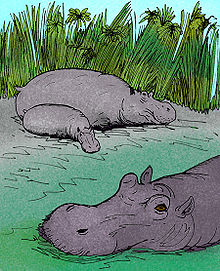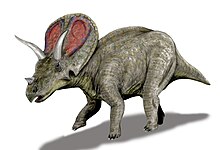Post by dinosauria101 on Feb 6, 2019 22:04:02 GMT 5
Hippopotamus gorgops
Hippopotamus gorgops ("Gorgon-eyed river horse") is an extinct species of hippopotamus. It first appeared in Africa during the late Miocene, and eventually migrated into Europe during the early Pliocene (where its fossils were first discovered). It became extinct prior to the Ice Age. With a length of 4.3 metres (14 ft), a shoulder height of 2.1 metres (6.9 ft), and a weight of 3.9 tons, H. gorgops was much larger than its living relative, H. amphibius. Another feature setting it apart from H. amphibius were its eyes. Modern hippos have eyes placed high on the skull, but H. gorgops took things a step further and had what could be described as short eye stalks, making it even easier for the creature to see its surroundings while (almost) fully under water.

Torosaurus latus
Torosaurus ("perforated lizard", in reference to the large openings in its frill) is a genus of herbivorous ceratopsid dinosaur that lived during the late Maastrichtian stage of the Cretaceous period, between 68 and 66 million years ago, though it is possible that the species range might extend to as far as 69 million years ago. Fossils have been discovered across the Western Interior of North America, from Saskatchewan to southern Texas. Torosaurus possessed one of the largest skulls of any known land animal. The frilled skull reached up to 2.77 metres (9.1 ft) in length. From head to tail, Torosaurus was about 9 m (30 ft) long and weighed four to six tonnes. Torosaurus is distinguished from the contemporary Triceratops by an elongate frill with large openings (fenestrae), long squamosal bones of the frill with a trough on their upper surface, and the presence of five or more pairs of hornlets (epoccipitals) on the back of the frill. Torosaurus also lacked the long nose horn seen in Triceratops prorsus, and instead resembled the earlier and more basal Triceratops horridus in having a short nose horn.

Credit to Wikipedia
Hippopotamus gorgops ("Gorgon-eyed river horse") is an extinct species of hippopotamus. It first appeared in Africa during the late Miocene, and eventually migrated into Europe during the early Pliocene (where its fossils were first discovered). It became extinct prior to the Ice Age. With a length of 4.3 metres (14 ft), a shoulder height of 2.1 metres (6.9 ft), and a weight of 3.9 tons, H. gorgops was much larger than its living relative, H. amphibius. Another feature setting it apart from H. amphibius were its eyes. Modern hippos have eyes placed high on the skull, but H. gorgops took things a step further and had what could be described as short eye stalks, making it even easier for the creature to see its surroundings while (almost) fully under water.

Torosaurus latus
Torosaurus ("perforated lizard", in reference to the large openings in its frill) is a genus of herbivorous ceratopsid dinosaur that lived during the late Maastrichtian stage of the Cretaceous period, between 68 and 66 million years ago, though it is possible that the species range might extend to as far as 69 million years ago. Fossils have been discovered across the Western Interior of North America, from Saskatchewan to southern Texas. Torosaurus possessed one of the largest skulls of any known land animal. The frilled skull reached up to 2.77 metres (9.1 ft) in length. From head to tail, Torosaurus was about 9 m (30 ft) long and weighed four to six tonnes. Torosaurus is distinguished from the contemporary Triceratops by an elongate frill with large openings (fenestrae), long squamosal bones of the frill with a trough on their upper surface, and the presence of five or more pairs of hornlets (epoccipitals) on the back of the frill. Torosaurus also lacked the long nose horn seen in Triceratops prorsus, and instead resembled the earlier and more basal Triceratops horridus in having a short nose horn.

Credit to Wikipedia


